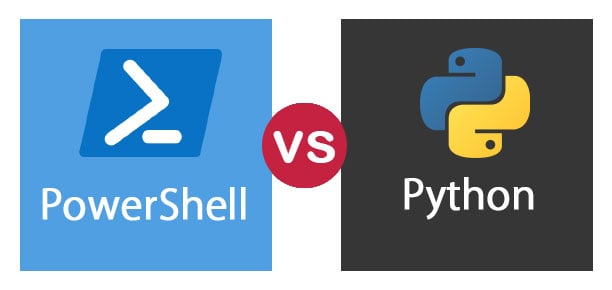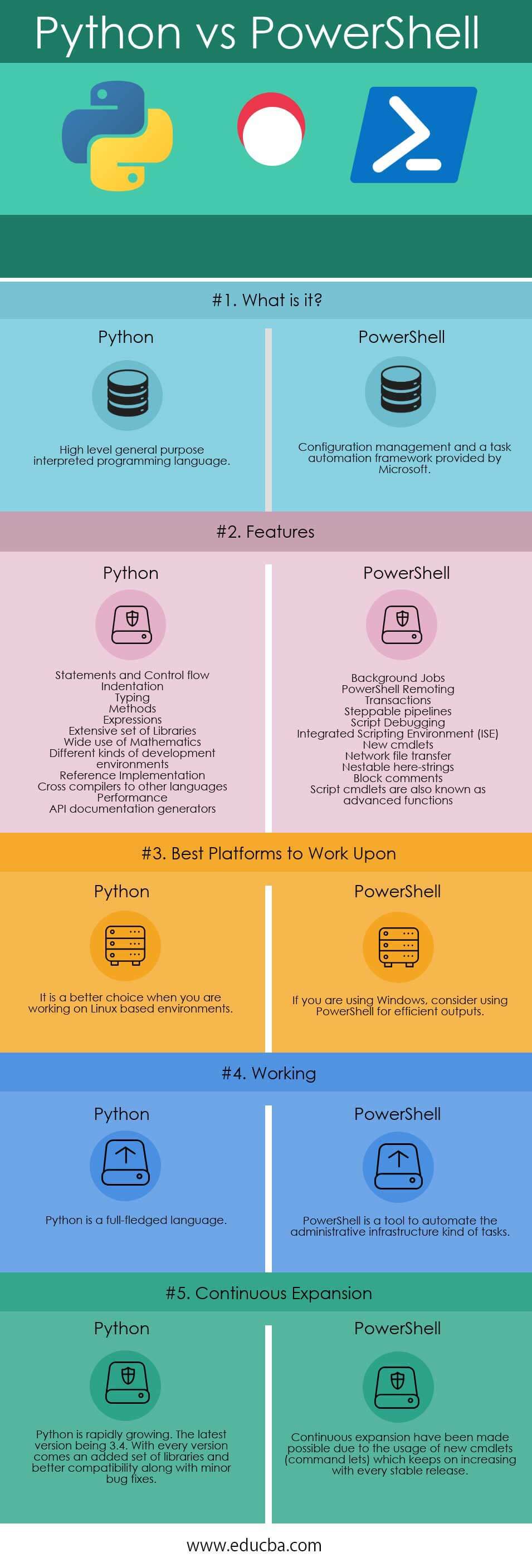Difference Between PowerShell vs Python
Microsoft today claims that Linux runs like a primary citizen on Microsoft Azure. The net score is already open-sourced, porting on Linux is already done, and PowerShell is following it. Powershell runs extremely well on CentOS and Ubuntu, Mac OS X, and RedHat Linux. Either Python or PowerShell can perform the same actions and achieve the same level of automation. Admins generally automate regular processes by making use of scripts. When discussing PowerShell, some functionalities are only possible on Windows OS. It must be noted, however, that PowerShell is not the only scripting language that has gained much popularity in the market. Still, Python is also among the widely used scripting language.
Almost all Linux users and admins would have executed .py scripts sometime somewhere. Python is available open source today in binary form as well. It is an extensively used interpretive programming language that is not just used for scripting purposes but can also support all those major features and capabilities supported by any High-Level Language. The primary features included are Object-oriented techniques, the provision of dynamically and arbitrarily splitting programs into modules, exception conditions, iterations, and conditional statements, and the option of expanding the programming language. Unlike most programming languages, variable and argument declaration is unnecessary; rapid programming is overly simplified and can rarely lead to ambiguities.
For Microsoft, PowerShell acts as the central interface at the command line for all Windows-based systems. This was launched as a Window feature in Windows 8. The integration of some other products, such as Cloud Applications and Exchange Server centering on Office 365 and Azure, are supported by many growing PowerShell cmdlets. Windows command line, popularly known as the command prompt, is a major feature in Windows 10 power menu, which can be easily replaced with the PowerShell (found in system settings). In the newer Windows 10, PowerShell is the default command line in the power menu.
The code written in Python is highly readable and efficient and, therefore, recyclable, unlike many other languages’ syntax, which uses brackets and semicolons. The indentation property is a unique feature not present in most programming languages. Python is available on a number of different operating systems.
PowerShell interpretively processes the code, and the feature related to object orientation is also common. It can also link processes and commands using pipes. Classic UNIX shells also support this technique; its use in an object-oriented manner opens up a plethora of possibilities. For example, a cmdlet such as a Get-Service responsible for creating Windows service returns the services it finds as objects. The command written after the pipe field is used to list the details. The strength of PowerShell is huge, and there is not second doubt. It eases the way IT professionals automate the task on their Windows system. The possibilities for processing files and folders go far beyond just this.
Head to Head Comparison Between PowerShell and Python(Infographics)
Below is the top 5 difference between PowerShell and Python:
Key Differences Between PowerShell and Python
Both PowerShell vs Python are popular choices in the market; let us discuss some of the major Difference Between PowerShell and Python:
Python is an advanced language that extends its capabilities of being just a scripting language. It goes a step ahead by providing iterative constructs, conditional statements, and easy-to-work-with syntax. In contrast, PowerShell is not just a language and extensively leverages the.Net style of infrastructure capabilities. Not all languages can support the infrastructure capabilities. Posh is one language that borrows this kind of pipeline from Perl, but it focuses more on the object-oriented working method, which is neat compared to Perl.
Python is a great choice when you talk about providing a tool efficient enough to replace BAT and CMD scripts on your Windows boxes, and it can also be used to run the scripts on the Linux boxes you provide. So, essentially it is a flexible language that can handle many tasks concurrently as and when required, whereas PowerShell is a better fit for administrative purposes. It is an efficient and versatile monitoring tool that keeps track of all the Windows boxes. It is imbibed with the power of.Net and many MS product features such as Exchange, Active Directory, etc., which is one of the major reasons why using PowerShell becomes a primary choice. PowerShell comes preinstalled in the majority of MS versions today.
PowerShell and Python Comparison Table
Below is the 5 topmost comparison between PowerShell and Python.
| The basis of comparison Between PowerShell vs Python |
Python |
PowerShell |
| What is it? | High-level general-purpose interpreted programming language | Configuration management and a task automation framework provided by Microsoft |
| Features | Statements and Control Flow Indentation
Typing Methods Expressions The extensive set of Libraries Wide use of Mathematics Different kinds of development environments Reference Implementation Cross-compilers to other languages Performance API documentation generators |
Background Jobs
PowerShell Remoting Transactions Steppable pipelines Script Debugging Integrated Scripting Environment (ISE) New cmdlets Network file transfer Nestable here-strings Block comments Script cmdlets are also known as advanced functions |
| Best platforms to work upon | It is a better choice when you are working on Linux-based environments | If you are using Windows, consider using PowerShell for efficient outputs |
| Working | Python is a full-fledged language | PowerShell is a tool to automate administrative infrastructure kind of tasks |
| Continuous Expansion | Python is rapidly growing. The latest version is 3.4. With every version comes an added set of libraries and better compatibility, along with minor bug fixes | The continuous expansion has been made possible due to the usage of new cmdlets (command lets), which keeps on increasing with every stable release |
Conclusion
PowerShell vs Python does not make an apple-apple comparison in many ways. Python is an interpreted high-level programming language whereas PowerShell provides a shell scripting environment for Windows and is a better fit if you choose to automate tasks on the Windows platform. Choosing among these depends on the environment you are using, as with Python, you get handsome support to work on Windows OS. Stay tuned to our blog for more articles.
Recommended Articles
This has been a guide to the top difference between PowerShell vs Python. We have discussed PowerShell vs Python head-to-head comparison, key differences, infographics, and comparison table here. You may also have a look at the following articles to learn more.




